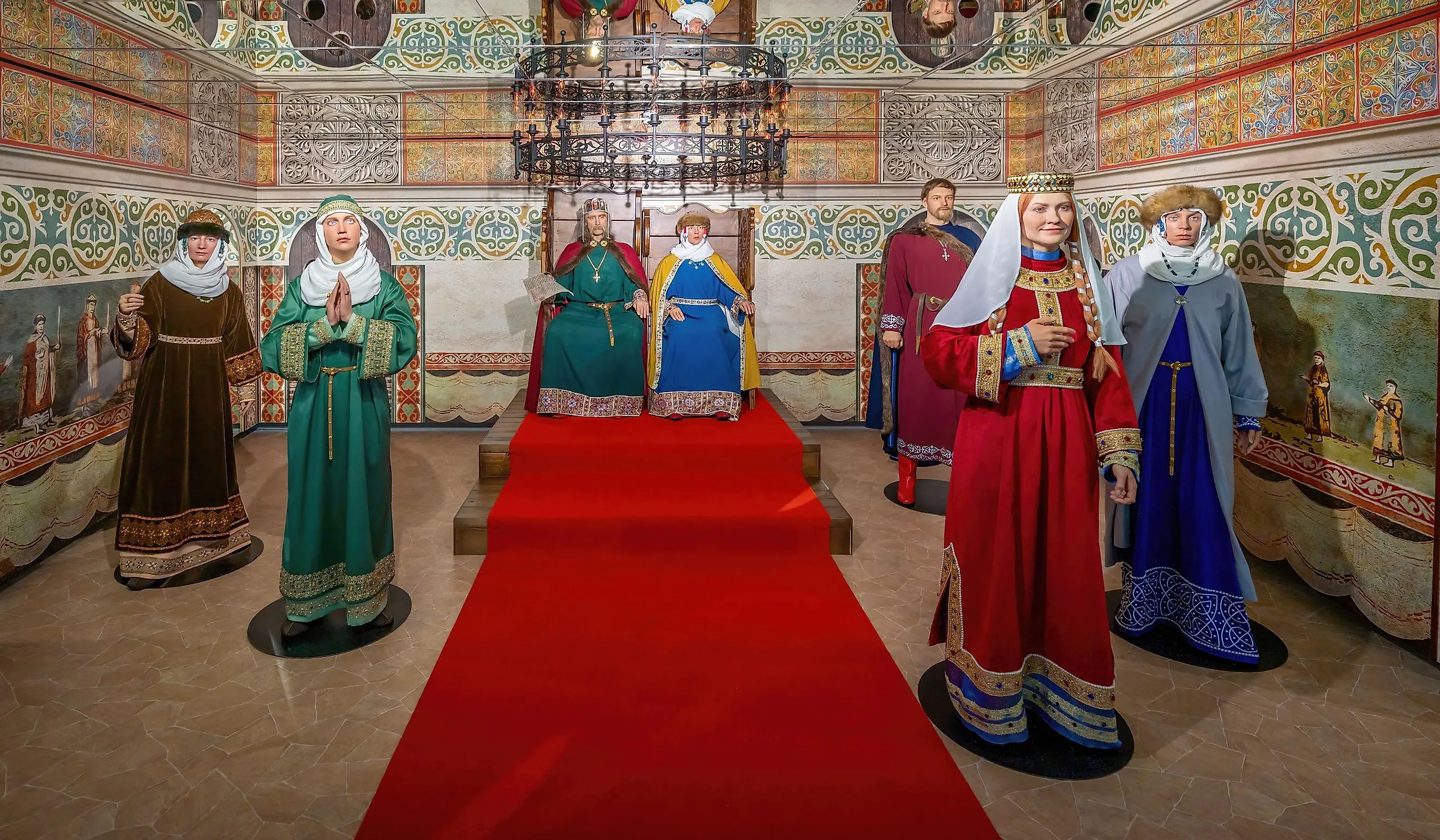
Kyivan Rus: The First East Slavic State
Long before Russia or Ukraine existed, there was Kyivan Rus.
Centuries before Russia or Ukraine raised arms against each other, Scandinavians made their way to Novgorod before moving on to Kyiv.
Kyivan Rus rose up during the 9th century and laid the foundations for the development of Russia, Ukraine, and Belarus.
The city of Kyiv was the heart of Kyivan Rus, a loosely bound federation of principalities, each under the governance of its individual prince.
The state reached its pinnacle in the late 10th century when it adopted Christianity from Byzantium, marking the conversion of Kyivan Rus into Orthodox Christianity.
It also was a crucial hub for trade between the Baltic and Black Seas, helping foster growth and cultural exchange. This fusion of Slavic and Byzantine aesthetics in art, architecture, and political rule emerged. While it was taking in and absorbing influences around it, it was truly becoming a culture of its own.
As quickly as the Kyivan Rus state rose to power, it fell almost as fast. A lack of internal unity and the Mongol invasion in the 13th century led to its end. Its influence, though, never went away.
The fragmentation of the state into smaller principalities laid the groundwork for the emergence of separate East Slavic entities.
Despite its eventual disintegration, the Kyivan Rus remains a crucial precursor to the formation of modern Russia, Ukraine, and Belarus, and therefore the Russia-Ukraine conflict.
Formation and Expansion of Kyivan Rus
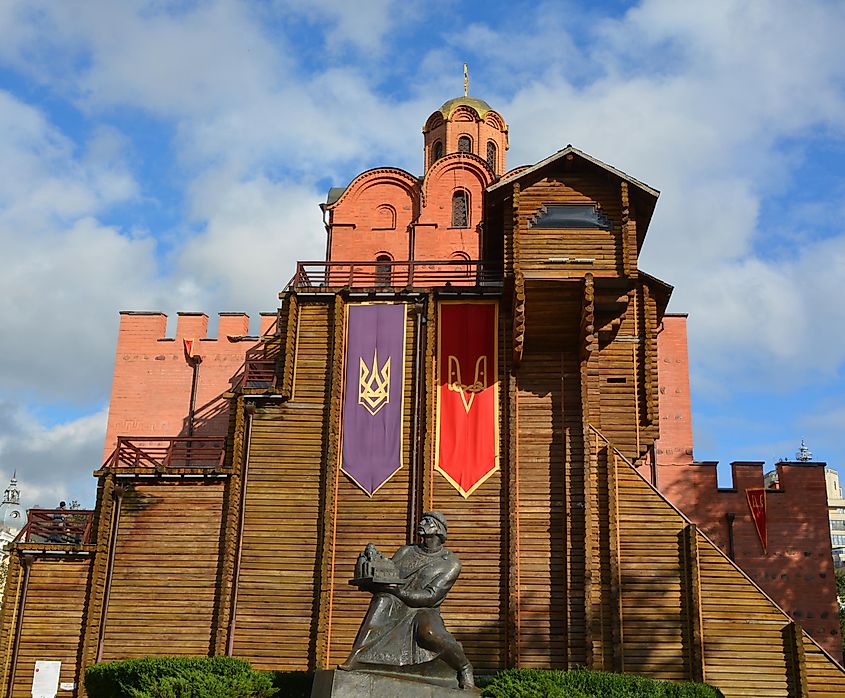
Tracking the history of this medieval state is tricky. The primary written source, the Primary Chronicle, was compiled in the 12th century, centuries after the formation of the Kyivan Rus.
When you are looking at the history of Kyivan Rus, you have to understand the bias of history gathered hundreds of years after.
Today, some people see Kyivan Rus very differently than others.
According to Andrew Wilson, author of The Ukrainians: Unexpected Nation, there are a couple of unique views held in Ukraine. One is that Kyivan Rus, at most, was a very loose collection of people. Another is that Kyivan Rus was an early Ukrainian state, and Russia was an off-shoot of this early state.
How does modern-day Russian historiography see it?
Well, one view sees all Eastern Slavs as being part of a greater Russian people whose history began with Kyivan Rus.
Even current Russian President Vladimir Putin has said Kyivan Rus makes up one of the cultural pillars of the Russian Empire, and Russians and Ukrainians are of "one people."
Another view is that Russia is the sole successor of Kyivan Rus. This view allows Russia to claim the mantle of the only legitimate successor of Kyivan Rus and, by extension, all of its territories. This idea is an important part of what led to the war against Ukraine in the present.
What we do know is Kyivan Rus was started when Vikings, made up of Norwegians, Swedes, and Fins, made their way into Eastern Europe as traders. These groups, primarily the Swedish Varangians, came down the Volkhov, Dvina, and Dnieper rivers, establishing settlements as a way to create a logistical trade route from Scandinavia to Byzantium.
The Chronicle says Prince Oleg was Kyivan Rus' initial leader during the later part of the 9th century. It is estimated his rulership started circa 882, and he significantly contributed towards strengthening this young East Slavic dominion.
Based on the information the Chronicle gives, his rule originally started in the town of Novgorod. He continued by sailing down the Dnieper to seize Kyiv, where he made the capital.
From the outset, there was a sense of solidarity among the Rus. This feeling of unity came from the concept that whatever divided the Rus was not as important as the enemies outside their borders.
Raids from nomadic tribes posed significant challenges to the stability and security of the cities under Oleg's control.
Oleg did two very important things. First, he helped defeat the Khazars, a nomadic group of Turkic tribes that freed groups of Slavs in the region. This helped consolidate power and expanded the territory under Kyivan Rus' control.
Secondly, and more importantly, Oleg is said to have established diplomatic and trade relations with the Byzantine Empire. On his way to Constantinople, Prince Oleg made a dramatic and symbolic impression on the Byzantine Emperor Leo VI.
According to the Primary Chronicle, Oleg, to emphasize his negotiation prowess and assert the strength of Kyivan Rus, he sailed his longship from the Dnieper River right to the walls of Constantinople, bypassing the traditional route. A trade deal was struck, and the two states began a profitable relationship with each other.
This is very important for the region's history because as this relationship grew and prospered, the Byzantine form of Christianity slowly made its way into Kyivan Rus.
As the Byzantine form of Christianity put its roots in Kyivan Rus, it left a legacy that shaped the religious and cultural identity of the region for centuries to come.
Christianity Arrives
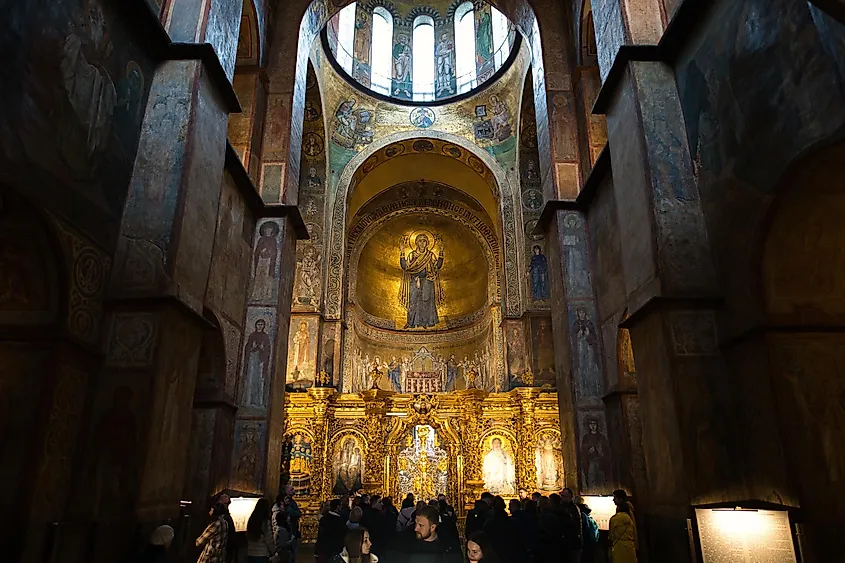
If Oleg was responsible for creating and fortifying the borders of Kyivan Rus, Prince Vladimir the Great was responsible for fortifying its Christian theology.
When you look at the transfer of power from one ruler to the next, a common theme with Rus was infighting. Princes fighting princes, and family fighting family. This was no exception when it came to Vladimir, who had to defeat his half-brother for control of both Kyiv and Novgorod.
Despite his eventual role in turning Rus into a Christian state, Vladimir was very much a pagan. According to the Chronicles, he had idols set up around his castle and was said to have dozens and dozens of concubines.
Anna Reid, who wrote Borderland: A Journey Through the History of Ukraine, says something changed. Vladimir started to see the power in a singular, "advanced" religion. But first, he wanted a bit of a taste test with the different religions in the area. He sent out missionaries to learn all he could about the nearby religions.
In the end, Byzantine Christianity was chosen. As you can imagine, it was a more complicated decision than throwing a dart at the board. In 987, Byzantine Emperor Basil II faced a rebellion, prompting him to seek military aid from Vladimir.
In exchange for assistance, Vladimir demanded the Emperor's sister's hand in marriage. The deal was accepted as long as Vladimir, along with his realm, underwent baptism.
Just like that, Kyvian Rus had become a Christian state but not a Catholic state, which has long-term geopolitical effects.
By choosing Christianity over Islam, he set the region on a road closely connected to Europe, as opposed to Asia. By choosing Orthodoxy over Catholicism, it made a clear divide with their neighbors, the Polish.
It also laid the groundwork for the development of a distinct Eastern Slavic Christian culture, separating Kyivan Rus from other neighboring pagan and non-Christian societies.
The Christianization of Kyivan Rus had long-lasting effects on the political structure, creating a close relationship between the Church and the ruling elite. The Church became a unifying force, contributing to the cohesion of the realm and the development of a distinct religious and cultural identity.
One small catch: the Byzantines had ecclesiastical control over Rus's conversion to Christianity. They could appoint an archbishop (called a Greek metropolitan), who acted as the representation for the Byzantine Emperor. So, Byzantine was finding ways to sneak in ways to control the Kyivan Rus state.
Despite this, Kyivan Rus benefited greatly. The Byzantine influence accelerated the growth of the still-young Kyivan civilization. In only a few generations, Kyivan Rus saw rapid development and started to give rise to artistic and literary achievements.
Yaroslav the Wise
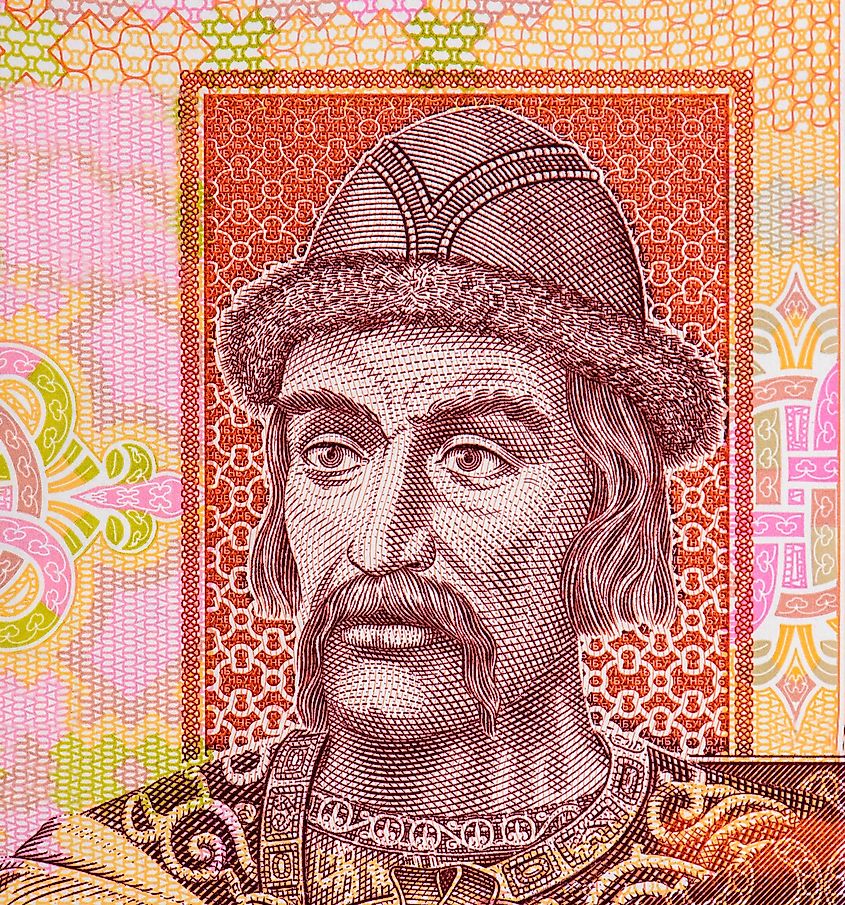
Now, if Vladimir was responsible for fortifying its Christian theology, his son Yaroslav laid down the foundations for legal and cultural development, shaping the future trajectory of Kyivan Rus.
First off, there will be some déjà vu. Yaroslav, echoing his father's actions, had to overcome and defeat his brother Sviatopolk - who was responsible for the death of three brothers - to attain the coveted grand prince position of Kyiv.
Prince versus prince warfare never truly disappeared in this kingdom. It was also one of the reasons the state fell apart.
When Yaroslav came to power, he was the 'last hurrah' of centralized rule. During his time, he did his best to consolidate power through cultural improvements and administrative changes.
It seems simple to say, but he accomplished this through some cunning moves. First off, during his time as leader, churches and monasteries regulated the rights of the clergy.
This helped expand Christianity through the Kyivan state. He also established more churches and monasteries and maintained close ties with the Byzantine Empire, which played a significant role in the religious and cultural development of the region.
One of the greatest things Yaroslav helped accomplish was the first written legal code in Kyivan Rus, known as the "Russkaya Pravda." It was a set of laws and regulations aimed at providing a systematic and fair legal framework for the society.
He undertook the enhancement of the nation through building endeavors, notably crafting the Saint Sophia Cathedral in Kyiv. In contemporary periods, this location is declared a UNESCO World Heritage Site and stands as an emblem of Ukrainian history and cultural legacy.
He also worked to create a diplomatic web in Europe, arranging marriages between his children and the royalty of other European countries. One of his daughters, Anna, married King Henry I of France.
He also saw a problem with how the transfer of power happened. He saw how almost every time a ruler died, there was a furious fight for power. So, he decided to split up his kingdom, passing out parts to his sons.
The idea, in theory, was that it would help avoid the infighting that had plagued the nation in the past. Unfortunately, the plan wouldn't work.
Serhii Plokhy, one of the leading historians on both Ukraine and Russia, said in his book The Gates of Europe: A History of Ukraine in only 37 years, there were almost three times as many rulers as in the previous 200 years combined.
The time of a unified Kyivan Rus ended with Yaroslav.
Fragmentation and Successor States
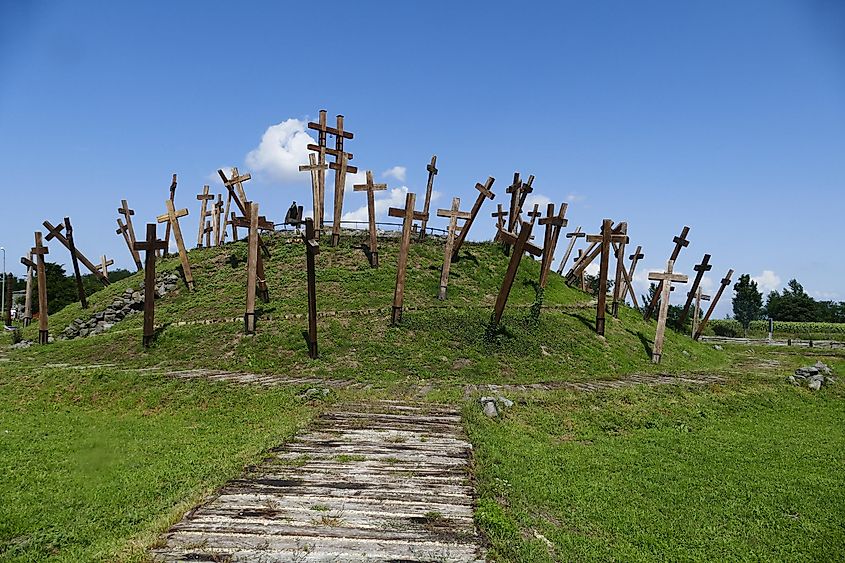
After Yaroslav's rule, Kyivan Rus experienced a gradual fragmentation. It was not just one thing that caused it but several important, distinct events. Over time, dynastic disputes over succession amongst ruling princes started to weaken the nation as a whole.
As we have seen, this is a common theme with Kyvian Rus. When a ruler passed away, it was not atypical for a power struggle to follow. However, after Yaroslav, this internal strife started to weaken the central authority, setting the stage for challenges against outside enemies.
In the mid-12th century, Kyivan Rus faced problems from the Cumans, a formidable nomadic Turkic tribe known for their relentless raids. These incursions strained the economic stability of the region and also played a pivotal role in accelerating the political fragmentation of Kyivan Rus'.
The attacks disrupted trade routes, depleted resources, and amplified the ongoing internal conflicts among the Rus' principalities.
By the late 12th century, a significant shift occurred with the rise of the Principality of Galicia-Volhynia within the western lands of Kyivan Rus'.
Under the leadership of Prince Roman the Great, an influential and strategic ruler, Galicia-Volhynia quickly established itself as a prominent and distinct center of power.
This marked a shift in the local landscape as a new center of power emerged. Galicia-Volhynia had its own distinct political and cultural developments, setting the stage for further divergence within Kyivan Rus.
The final curtain for the state came in the 13th century with the Mongol invasion led by Batu Khan poured into the Rus lands.
While Moscow and Kyiv were both burned and sacked, what happened in Kyiv was much worse and much more brutal. Kyiv was not just sacked; it was destroyed. It was a graveyard. For years after, stories talked about how the bones of victims still covered the streets in the ruins of the city.
The invasion effectively destroyed Kyivan Rus, leading to the establishment of the Golden Horde, a Mongol state that had control over the fragmented Rus principalities. In the aftermath, the once-unified state splintered into independent entities.
Gradually, the different principalities that remained of Kyivan Rus led to distant empires in the future.
Vladmir-Suzdal acted as the precursor for Russia. Some feel Polatsk was the precursor for the nation of Belarus. The aforementioned Galicia-Volhynia principality acted as the precursor ancestor of Ukrainian nationalism.
After Kyivan Rus was broken up, there was a cultural and religious divergence, with western territories inside modern-day Ukraine maintaining closer ties with European influences. The eastern regions, particularly areas near modern-day Moscow, were more influenced by Mongol and Byzantine traditions.
Even though it had been burned down, Moscow began to rise in prominence as a significant city, capitalizing on the weakened central authority.
The fragmentation left a lasting legacy on the subsequent histories of Russia and Ukraine. Russia evolved as a centralized state with a strong autocratic rule, influenced by the Mongol period, while Ukraine experienced a complex history of interactions with neighboring powers.
The division during the Kyivan Rus era played a pivotal role in shaping the distinct historical trajectories of Ukraine and Russia.
Kyivan Rus in Contemporary Discourse
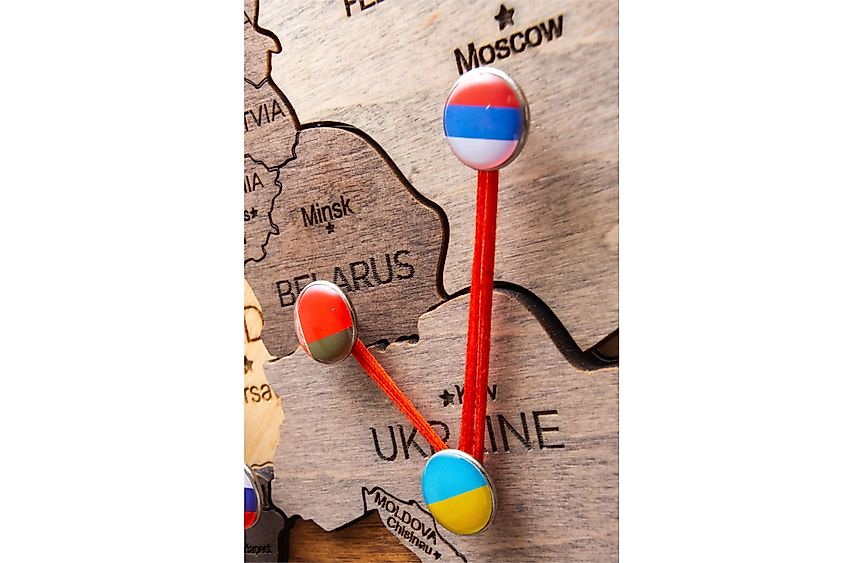
Nowadays, all three of Russia, Ukraine, and Belarus call Kyivan Rus the beginning of their heritage.
In Russian discourse, Kyivan Rus is often acknowledged as a foundational period that laid the groundwork for the development of the Russian state. The legacy of Kyivan Rus is celebrated as part of Russia's historical identity.
In Ukrainian narratives, Kyivan Rus also holds a central place as the cradle of Ukrainian statehood and identity. The period is commemorated for its cultural and political significance, emphasizing the distinctiveness of Ukrainian heritage. The establishment of the Saint Sophia Cathedral and the Russkaya Pravda are highlighted as symbols of Ukraine's rich cultural and legal traditions.
While both Russian and Ukrainian historical narratives recognize the importance of Kyivan Rus, the interpretations vary. How the countries both view Yaroslav the Wise is a perfect example of that.
In Russia, Yarosla is often portrayed as a smart and capable ruler who significantly contributed to the development of a centralized state. His achievements, such as the Russkaya Pravda and alliances with European powers, are emphasized as part of the broader Russian historical narrative, showcasing a connection to European cultural and legal traditions.
Well, in Ukrainian historical narratives, Yaroslav is also celebrated as a national hero who laid the foundations for Ukrainian statehood. His support for the Christianization of Kyivan Rus and cultural initiatives, such as the construction of the Saint Sophia Cathedral, is highlighted as integral to Ukrainian heritage.
In modern times, his physical face is represented differently in the two nations. If you look at a 1000 ruble note, you'll see the Russian representation of Yaroslav. He is fully bearded. On the other hand, on the Ukrainian 2 Hryvnia banknote, he is wearing a mustache that looks quite similar to the well-known Cossack-style appearance.
Who exactly 'owns' the rights to the heritage of Kyivan Rus has been talked about by historians for centuries. It is clear, though, that both Ukraine and Russia see Kyivan Rus as a vital part of their collective history.
Final Thoughts
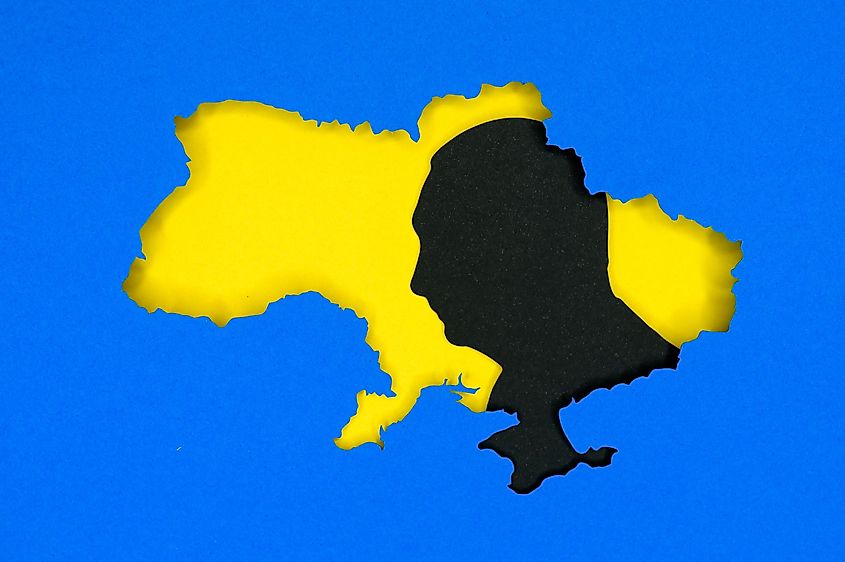
Kyivan Rus, the medieval East Slavic state, laid the groundwork for modern Russia, Ukraine, and Belarus.
This historical journey started with the formation of Kyivan Rus through the peak under Prince Vladimir the Great, the Christianization orchestrated by Prince Vladimir, and the challenges faced by Yaroslav in maintaining unity.
It came crashing down with the state's fragmentation and external threats like the Mongol invasion, leaving a lasting impact on the trajectories of Russia and Ukraine.
Kyivan Rus played a foundational role in shaping the identities of both Ukraine and Russia, despite the divergence in their interpretations of historical figures and events.
The enduring significance of Kyivan Rus is evident in contemporary discourse, where Russia and Ukraine lay claim to their heritage, showcasing the relationship of these countries despite their shared heritage.
It also stands as a crucial precursor to the ongoing Russia-Ukraine conflict. One Russian view sees all Eastern Slavs as being part of a greater Russian people whose history began with Kyivan Rus.
When the current Russian President Vladimir Putin says Russians and Ukrainians are "one people," this history is his justification to 'reunite' them.
As both nations grapple with the complexities of the Russia-Ukraine conflict, the legacy of Kyivan Rus persists, serving as a historical touchstone that continues to influence how the two countries view the region.
Works Cited:
Cross, Samuel Hazzard, and Olgerd P. Sherbowitz-Wetzor, translators and editors. The Russian Primary Chronicle: Laurentian Text. The Mediaeval Academy of America, Cambridge, Massachusetts, 1953. Internet Archive, https://archive.org/stream/the-russian-primary-chronicle/The%20Russian%20Primary%20chronicle_djvu.txt.
Charques, R.D. Between East and West: The Origins of Modern Russia: 862 - 1953. Pegasus Books, 1956.
Dvornik, Francis. “Byzantine Political Ideas in Kievan Russia.” Dumbarton Oaks Papers, vol. 9/10, 1956, pp. 73–121. JSTOR, https://doi.org/10.2307/1291093.
Font, Márta. “Old-Russian Principalities and Their Nomadic Neighbours: Stereotypes of Chronicles and Diplomatic Practice of the Princes.” Acta Orientalia Academiae Scientiarum Hungaricae, vol. 58, no. 3, 2005, pp. 267–76. JSTOR, https://www.jstor.org/stable/23658651.
Hosking, Geoffrey. Russian History: A Very Short Introduction. 1st ed., Oxford University Press, 2012.
Lind, John H. “The Russo-Byzantine Treaties and the Early Urban Structure of Rus’.” The Slavonic and East European Review, vol. 62, no. 3, 1984, pp. 362–70. JSTOR. https://www.jstor.org/stable/4208908.
"Oleg: Ruler of Novgorod” Encyclopedia Britannica, 2023. Funk & Wagnalls New World Encyclopedia, https://www.britannica.com/biography/Oleg.
Padokh, Yaroslav. “Ruskaia Pravda” Internet Encyclopedia of Ukraine, 1994. https://www.encyclopediaofukraine.com/display.asp?linkpath=pages%5CR%5CU%5CRuskaiaPravdaIT.htm.
Plokhy, Serhii. The Gates of Europe: A History of Ukraine. 2nd ed., Basic Books, 2022.
Plokhy, Serhii. Lost Kingdom: The Question For Empire and the Making of the Russian Nation. 1st ed., Basic Books, 2017.
Reid, Anna . Borderland : A Journey Through the History of Ukraine. 2nd ed., Basic Books: Member of The Perseus Book Group, 2014.
Sevcenko, Ihor. “The Christianization of Kievan Rus” The Polish Review, vol. 5, no. 4, 1960, pp. 29–35. JSTOR, https://www.jstor.org/stable/25776328.
The Editors of Encyclopaedia Britannica. “Vladimir I: Grand Prince of Kyiv” Encyclopedia Britannica, 2023. Funk & Wagnalls New World Encyclopedia, https://www.britannica.com/biography/Vladimir-I.
Wilson, Andrew. The Ukrainians: Unexpected Nation. 4th ed., Yale University Press, 2015.
Wortman, Richard. “Cultural Metamorphoses of Imperial Myth under Catherine the Great and Nicholas I.” Visual Texts, Ceremonial Texts, Texts of Exploration: Collected Articles on the Representation of Russian Monarchy, Academic Studies Press, 2013, pp. 122–44. JSTOR, https://doi.org/10.2307/j.ctt21h4wkb.12.
Yekelchyk, Serhy. Ukraine: What Everyone Needs To Know. 2nd ed., Oxford University Press, 2020.











